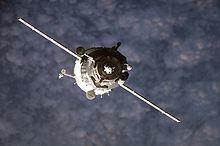COSPAR ID 2007-008A Spacecraft type Soyuz-TMA 11F732 Crew size 3 Landing date 21 October 2007 | Mission duration 196 days, 17 hours Manufacturer RKK Energia Dates 7 Apr 2007 – 21 Oct 2007 Launch date 7 April 2007 | |
 | ||
Operator Roscosmos State Corporation Members | ||
Soyuz tma 10 launch exp 15 simonyi
Soyuz TMA-10 was a human spaceflight mission using a Soyuz-TMA spacecraft to transport personnel to and from the International Space Station (ISS). The mission began at 17:31:09 UTC on April 7, 2007 when the spacecraft was launched from the Baikonur Cosmodrome by a Soyuz FG launch vehicle. Soyuz TMA-10 brought to the station two members of ISS Expedition 15 crew, along with one spaceflight participant. It remained at the space station as an escape craft until it was replaced by Soyuz TMA-11 in October 2007.
Contents
- Soyuz tma 10 launch exp 15 simonyi
- Soyuz tma 10 undocked from iss before ballistic re entry
- Docking with ISS
- Mission highlights
- References
Soyuz tma 10 undocked from iss before ballistic re entry
Docking with ISS
Mission highlights
Soyuz TMA-10 docked to the ISS on April 9, 2007 at 22:10 UTC, following two days of free flight. Its two Russian crew members remained on the station until the spacecraft's return to Earth in October 2007. Spaceflight participant Charles Simonyi returned to Earth aboard Soyuz TMA-9 on April 21, following eleven days of ISS handover operations.
TMA-10 undocked from the ISS at 07:14 UTC on October 21, and deorbit occurred at 09:47. During atmospheric re-entry, the spacecraft transitioned to a ballistic reentry, resulting in it landing west of Arkalyk, approximately 340 km (210 mi) northwest of the intended Kazakhstan landing site. The trajectory was reported by the crew as soon as they came out of the communications blackout caused by plasma surrounding the spacecraft. (A ballistic trajectory is a backup re-entry mode that takes over if something fails during normal re-entry.) A Commission of Inquiry determined that the ballistic re-entry was caused by damage to a cable in the spacecraft’s control panel, which connected to the control panel with the Soyuz descent equipment. Landing occurred at 10:36 GMT. A ballistic trajectory entry had happened previously, with the Soyuz TMA-1 mission that returned Expedition 6. The information about the failure of a connector in service panel was faulty. In actuality, the Service module (PAO) had failed to separate from the re-entry module (SA), and the ship had entered the atmosphere with the opposite orientation. Explosive bolts in connection struts between the Re-entry module and the Service module had failed to explode. Fortunately, the heat had melted the failed struts and the re-entry module had separated from the service module - the changed trajectory of the ship had caused the switch to a ballistic emergency landing. The same situation had happened during the Soyuz 5 mission in 1969. The Soyuz re-entry module was, and still is, protected on all sides with thermal insulation, so the struts melted before the crew entry hatch was damaged or destroyed, thus saving the crew. The Russians kept the failure of the Soyuz TMA-10 a secret until it happened again on the Soyuz TMA-11 with a NASA astronaut on board. This infuriated NASA (the Commission of Inquiry had lied to them) and this led to further investigation as well as special EVA activity on the ISS to check the docked Soyuz TMA-12 and its explosive bolts in their connection struts.
